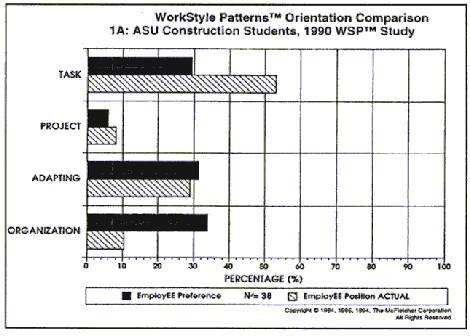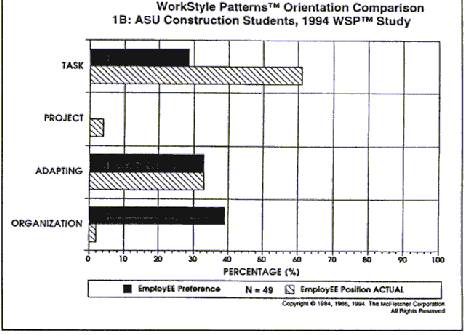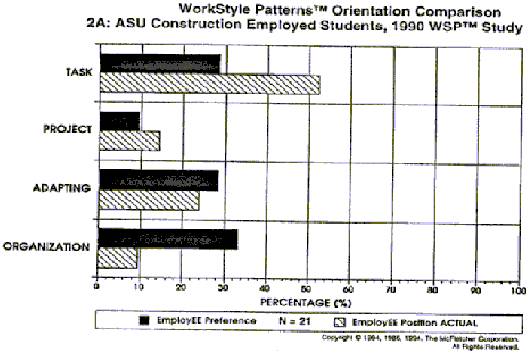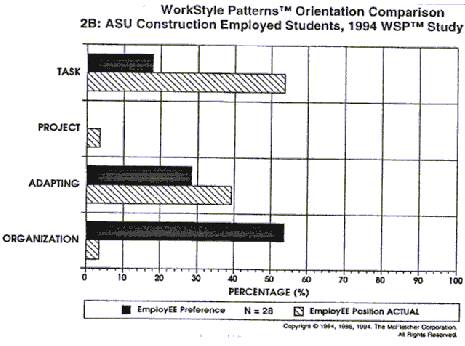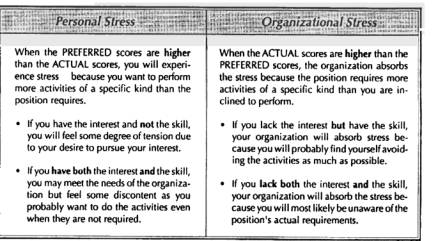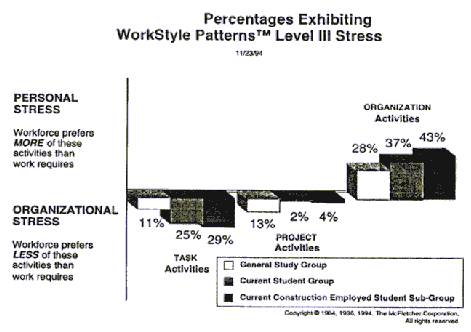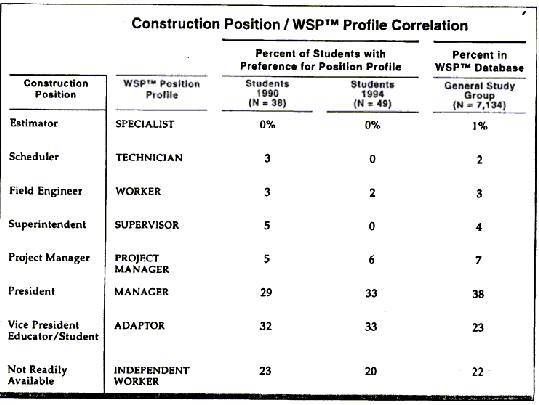|
(pressing HOME will start a new search)
|
|
WorkStyle Profile for Construction Students: A Time to Stretch
|
Ken Walsh Del
E. Webb School of Construction Arizona
State University Tempe,
Arizona |
Ray Newitt The
McFletcher Corporation Scottsdale,
Arizona |
|
This study is a follow-up to Badger and Wanner (1991) to explore the degree of alignment between the Constructors' PREFERRED approach to work and the ACTUAL requirements of their positions. In order to assess the impact of their implemented educational recommendations, the WorkStyle Patterns" Inventory (WSP') was administered in 1994 to another group of construction students. A comparison between the two student groups reveals that individual preferences are difficult to influence, WorkStyle Alignment has not improved and the potential for Personal and Organizational Stress (based on work approach) for the 1994 study group is at higher levels than in the general workforce. Recommendations for educators, industry, and students are provided with an emphasis on a partnership requiring all to stretch beyond what is traditionally comfortable. Keywords: Productivity, Organizational Effectiveness, WorkStyle Stress, Construction Management, Professional Development, Alignment |
Introduction
In
"The Educators Role, Aligning The Peg And The Hole," Badger and Wanner
(1991) identified the primary role of the construction educator was to
"meet the needs of the construction industry by providing quality graduates
(who) bring technical knowledge to improve industry performance." They went
on to identify a significant lack of alignment between PREFERRED WorkStyles and
construction industry requirements as a key issue requiring the attention of
both the educator and the construction industry. Badger and Wanner recommended
the following three-pronged approach for improving the misalignment identified
in the study:
1.
Attract potential constructors with appropriate WorkStyle preferences for the
Construction Profession (educator).
2.
Integrate managerial and interactive skills in construction schools' curriculum
to influence student preferences (more "management" in Construction
Management, educator).
3.
Be sensitive to workforce professional development
and
career pathing (industry).
Badger
and Warmer's (1991) recommendations regarding educational approaches focused on
the work preferences of students attracted to the program and the methods for
educating these students. In an attempt to implement these recommendations, the
Del E. Webb School of Construction (DEWSC) at Arizona State University modified
their recruiting and educational approaches. A follow-up study to the Badger and
Wander (1991) study was conducted in October, 1994, to assess the impact of
implemented educator recommendations and to identify additional insights to
provide direction for the future. This paper compares the results of the
follow-up investigation with Badger and Warmer's (1991) initial work and
provides further recommendations for improvement. Comparisons will be based upon
the undergraduate student responses of both studies who respectively represent
38 (1991) and 49 (1994) students.
Alignment Instrument
The
concept of alignment addressed by Badger and Wanner originated from The
McFletcher Corporation's WorkStyle Patterns (WSP) Inventory. The WSP alignment
assessment process is based on a comparison between actual work requirements and
the way people prefer to approach work activities. This assessment determines
WorkStyles; how an individual prefers to work (the want) and how an individual
views his or her current position's ACTUAL work (the is).
This
assessment also reveals the discrepancy between the individual's preferred
approach to work and the position's required approach to work. Descriptive
WorkStyle Profiles provide comparative data about the workforce and their work
activities. This knowledge enables employees and employers to work together for
closer alignment which creates greater organizational productivity and enhanced
individual satisfaction.
The
premise of the WSP°" Alignment process is that each person prefers and
each position requires different degrees of TASK, PROJECT, and ORGANIZATION
Orientation activities. The degree to which a person prefers to exercise each
Orientation determines his or her PREFERRED WorkStyle. The degree to which a
position requires that each Orientation be carried out determines its ACTUAL
WorkStyle.
There
are four WSP Orientations which represent how an individual prefers to think
about work or how the work requires whoever is in the position to think about
the work. These Orientations are:
TASK
Identification
with the Product or Service, through performing specific work activities.
PROJECT
Identification
with Projects and their People through coordinating and linking activities.
ORGANIZATION
Identification
with Goals and Results through initiating organizational activities.
ADAPTING
Identification
with all three types of activities through a combined Orientation that balances
all three Orientations in a responsive and supportive manner.
The
inventory consists of 18 statements (9 PREFERENCE, 9 ACTUAL) with 4 responses
per statement. Individuals rank the four responses per statement from 4 (meaning
most) to 1 (meaning least). Completion of the WSP"" Inventory
generates numeric scores for each of the Orientations. These scores are used
to determine a WorkStyle Profile. WorkStyle Profiles reflect the combination of
Orientation scores, a "pattern" of the work approach. The WorkStyle
Orientation represents the thinking mode to work, whereas the WorkStyle Profile
represents the way to carry out that thinking. The degree of misalignment
between the PREFERRED and ACTUAL Orientations and Profiles indicates potential
individual and organizational stress, or productivity and individual
satisfaction.
Changes in Educational Approach
Badger
and Wanner (1991) identified significant misalignment in their study group as
preferences to work independently conflicted with position requirements to
work interdependently with improved coordination. In response to these
findings and in an effort to improve the identified misalignment, DEWSC modified
its educational approach in two main areas: recruitment and group learning.
While the changes to be discussed below are occurring in many educational
arenas, the Badger and Wanner (1991) results provided an impetus to accelerate
adoption of the following modifications at DEWSC.
Recruitment
The
Del E. Webb School of Construction, in partnership with local industry, has
developed the Construction Recognition Banquet as an annual recruitment event.
The focus of the event is to expose high school students and education
professionals to the exciting opportunities in construction. This banquet
showcases construction and construction professionals to outstanding high
school students, educators, and guidance counselors. Interaction and informal
discussions between students, educators and professionals are key to the
success of this event. This is accomplished by seating at least one
representative of the local industry and one DEWSC faculty member or student at
each table. The Outstanding Woman Contractor and Outstanding Minority Contractor
awards are given at the event, and a keynote lecture is presented pertinent to
the construction industry.
Following
the observation of significant misalignment in the 1991 study, the emphasis of
the presentations at the Construction Recognition Banquet have changed. The
requirements that constructors be "team players," and be able to
coordinate and manage complex projects with complicated staff requirements have
been stressed in recent years. This theme is also reflected in revised
recruiting videos and brochures in the hope of attracting more students with
preferences in these critical areas.
Group Learning
In
addition to recruiting students with preferences to work interdependently, the
faculty at the School created increased opportunities for group learning, team
experience, and coordination in the curriculum. Group projects have become a
part of most courses within DEWSC. The objective of each project is to provide
educational contact with a particular subject area. However, taken
institutionally, the objective is to provide opportunities for students to
develop skills for working in teams and understanding group dynamics
throughout the educational process. Some faculty members argue that this goal is
as important as the contact with the individual subject areas.
The
operation of team assignments is different in each course. In some courses
students are allowed to choose their own groups, while in other courses
instructors determine group membership. Sometimes a group leader or spokesperson
must be selected. Usually the group product consists of a written document and
an oral presentation of results, though at times only a written report is
required. By providing a variety of group experiences in different courses, each
student experiences a number of group roles, a variety of group compositions,
and a multiplicity of "ground rules." Team assignments are intended to
serve as an experiential model for the operation of actual projects or project
management after graduation, albeit on a smaller scale. In this way, the
students should have an increased understanding for the character of the
construction industry, and be better prepared to join its ranks as more
productive members.
Evaluation/Discovery
In
order to evaluate the impact of the change; in educational approach, a
comparison between the student groups of the 1991 and 1994 studies is presented
in this section. The 1994 data consists primarily of students it their last year
of the program. Because moss students who were seniors in 1994 were recruited
prior to the change in recruiting approach, the data does not necessarily
reflect the impact of the change. However, it doe: provide insight into the
effect that more group learning opportunities had on individual preferences.
WorkStyle PREFERENCE Results
Figure
1 presents the WorkStyle Patterns' Orientation comparison between the 1991 and
1994 study groups.
|
|
|
Figure
1A. |
|
|
|
Figure
1B. |
The
WorkStyle PREFERENCE results (solid bars) in Figure 1 substantiate WorkStylc
Patterns" historical trends that skill development and training do not
change individual preferences; but rather provide opportunities for individuals
to effectively manage WorkStyle differences. A comparison o: Figures IA and 1B
reveals similar percent ages for the TASK and ADAPTING approaches from the 1991
and 1994 study groups. The two figures also reveal an increase in the ORGANIZA
TION approach and a reduction in the PROJEC7 approach. The initial objective for
instituting the educational changes described above was to reduce TASK
Orientation and increase the PROJECT and ORGANIZATION Orientations of the graduates.
However, based on these results, the increase in group learning activities
appears to have had a negligible influence on student preferences away from
the TASK Orientation. In other words, it is very difficult to change the way
people like to do their work.
As
stated before, the WorkStyle Patterns" Inventory requires respondents to
rank four responses to each of the nine statements dealing with preference (from
"4" meaning "most" to "1" meaning
"least"). A review of response rankings of the 1994 study group for
the WSP"" Inventory PREFERENCE statements provides insight that
supports the group's higher ORGANIZATION to influence goals and results and
lower PROJECT PREFERENCES to coordinate projects and people.
Most Preferred Student Responses
The
following responses are the study group's highest ranking responses for each of
the nine statements dealing with preference:
|
Know
how the project fits into the larger context. Work
with people who understand what the goals are. Work
with people who have stimulating and innovative ideas. Respond
to activities that require my specialized talents. Map
out forthcoming events and requirements. Work
in an environment where there is communication. View
new experiences as opportunities. Carry
out individual activities that show results. Set
priorities and target dates. |
The
majority of these responses reflect a WorkStyle PREFERENCE to understand the
whole and to be involved in a broader context.
Least Preferred Student Responses
The
following responses are the study group's lowest ranking responses for each of
the nine statements dealing with preference:
|
Be
in the middle of things. Participate
only when something is interesting. Work
with people who are willing to be a part of the group. Respond
to people's needs and feelings. Schedule
tasks for others. Work
in an environment where others do not expect a lot in a short time. Observe
and evaluate the reactions of others to new experiences. Coordinate
own activities with those of others. Find
people to help. |
For
the most part, these responses depict a low PREFERENCE for a work activities
that includes group involvement and coordination.
Based
on the trend from the comparison of Badger and Wanner (1991) with the 1994 data
(Figure 1), the impact of modification in the DEWSC educational process has been
negligible. However, there are certain benefits to the increased use of group
learning outside of the hoped-for modification of PREFERENCES. The use of these
tools introduces students to an interactive environment they will encounter upon
entering the workforce. Additionally, there is evidence that student retention
rates may be significantly increased over traditional approaches (National
Training Laboratories).
Position ACTUAL Results
Similar
to PREFERENCES, the ACTUAL Orientations are the nine statements (from
"4" meaning "most" to "1" meaning
"least") dealing with how individuals actually work. From an ACTUAL
WorkStyle perspective, it is important to look at the subgroup (Construction
Employed Students) of students who have or had employment in the construction
industry and were able to use their constriction industry position as their
frame of reference in responding to the WSPO Inventory statements about how they
perceived their ACTUAL work requirements. This subgroup comprised 55%of the
original study group and 57% of the current study group participants-a majority
in both .
While
students' PREFERRED activities increased in ORGANIZATION Orientation to
influence goals and results from 1991 to 1994, a comparison of the WorkStyle ACTUAL
requirements depicted with striped bars in Figure 2 reflects reductions in both
the ORGANIZATION and PROJECT requirements. The TASK requirements reflected a
minimal increase (52%to 54%) while the ADAPTING approach posted the largest
increase, from 24%to 39%. The TASK and ADAPTING Orientations comprised 93%, or
26 out of 28 of the total 1994 respondents of the Construction Employed Students
Sub-Group. This is a little surprising when nine students held positions such as
Owner, President, Construction Manager, Project Manager, Assistant Project
Manager, Superintendent, and Foreman-positions which would be expected to
reflect PROJECT and ORGANIZATION Orientations.
As
was presented earlier in the discussion of PREFERENCE data from Figure 1, are
view of ACTUAL Response Rankings supporting the 1994 Construction Employed
Student Sub Group results presented in Figure 2 provides insight that supports
the groups higher TASK and lower PROJECT and ORGANIZATION ACTUALS.
Most
Required Work Activities for Construction Employed Students ACTUAL
The
following responses are the study group's highest ranking response for each of
the nine statements dealing with the positions' ACTUAL requirements:
|
Contribute
own skills and expertise. Focus
on individual accomplishments and contributions. Concentrate
on own immediate tasks and responsibilities. Decide
who should be apprised of new information affecting operations. Be
knowledgeable and communicative. Don't
like to receive conflicting instructions. Need
a productive environment and appropriate tools or processes. Advise
appropriate person of incorrect work of others. Carry
out tasks that contribute to organizational goals. |
These
activity responses largely reflect a WorkStyle ACTUAL that focuses on individual
skills, responsibilities, and contributions.
Least
Required Work Activities for Construction Employed Students ACTUAL:
The
following responses are the study group's lowest ranking response for each of
the nine statements dealing with the positions' ACTUAL requirements:
|
Challenge
or change the work being done. Improve
the image of the organization. Take
responsibility for what others are doing. Ignore
new information unless it is in one's own area of responsibility. Be
an influential force. Obtain
approval for decisions. Challenges
to deal with forces larger than self. Use
incorrect work of others to evaluate purpose of assignment. Interpret
organizational goals to others. |
These
activity responses reinforce the WorkStyle ACTUAL focus on individual
contribution presented above and not on the group or organization as a whole.
Though
this study does not evaluate the impact of the construction industry on the
WorkStyle ACTUAL responses, it does reveal the following potential concerns
when compared with the PREFERENCE data:
The
trend seen in the decrease in PROJECT PREFERENCE of the Total Study Groups (5%
to 0%) and the decrease in perceived PROJECT ACTUAL (14% to 4%) of the
Construction Employed Student subgroup is headed in a precarious direction.
Due to modern day re-engineering efforts, organizations often need more
coordination and communication and more people who prefer such activities to
compensate for Middle Management and Supervisory positions that, no longer
exist. Re-engineering efforts have been observed to have these effects in all
industries, which are not specific to the construction industry alone. It is
McFletcher's observation that when perceived PROJECT activities decrease, there
is an unwelcome increase in ADAPTING activities as employees respond to
surprises, lack of coordination and other unplanned events. In fact, according
to McFletcher's research, if the ADAPTING ACTUAL reaches and exceeds 40%, the
entire organization or industry enters a state of crisis management which is
difficult, if not impossible, to reverse.
|
|
|
Figure
2A. |
|
|
|
Figure
2B. |
Looking
at the Construction Employed Student SubGroup in Figure 2 the increase in
ORGANIZATION PREFERENCE (33% to 54%) combined with the reduction in perceived
ORGANIZATION work requirements (ACTUAL) (10% to 4%) further increases
discrepancy between student preferences and opportunities for influencing goals
andresultsfrom24%to50%. This growing misalignment will contribute to both
Personal and Organizational Stress.
Alignment and WorkStyle Stress
Alignment
simultaneously embraces the concepts of productivity and stress. A discrepancy
between one's PRE FERRED WorkStyle and one's ACTUAL WorkStyle car produce
various degrees of stress, which may be manifested in a variety of ways (Table
1). Typical personal response: to discrepancies include apathy and/or low
productivity, irritability and frequent complaints, and health disorders or
illness. A person with a significant WorkStyle discrepancy may even make changes
in the position in order to meet his or her own personal needs. This can cause
both Personal and Organizational Stress. Organizational Stress can be observed
through misunderstandings of work expectations, product quality and customer
service problems, missed deadlines, and higher turnover.
|
|
|
Table
1. |
In
addition to differentiating between Personal and Organizational Stress, it is
important to determine the level of stress from the degree of misalignment.
That is to say, the greater the discrepancy between the PREFERRED and ACTUAL
Profile scores in each Orientation, the more stress is manifested. The
McFletcher Corporation identifies three Levels of Stress based upon the degree
of misalignment between the PREFERRED and ACTUAL Orientations. The most
significant condition is referred to as Level III Stress, and indicates a
conflicting difference likely to impact both the individual and the
organization. Figure 3
represents
Level III Stress percentages for the McFletcher General Study Group, the current
ASU Construction Student Group, and the current Construction Employed Student
Sub-Group. The General Study Group represents respondents from a variety of
industries and professions in the McFletcher Corporation's Data Base. A
comparison of the student groups with the General Study Group indicates that:
|
|
|
Figure
3. |
As
indicated from this study's sampling, the construction industry might be
experiencing much higher Organizational Stress (Level III) in the TASK
Orientation than the General Study Group. The discrepancy is even worse for the
Construction Employed Students Subgroup (students prefer much less task).
Employees
in the construction industry might be experiencing a much higher level of
Personal Stress in the ORGANIZATION Orientation than the General Study Group.
This picture worsens when you identify that 82% of this group are between the
ages of 23 and 32-meaning they could experience this level of stress for many
years to come.
Partnership with Industry
Even
though Badger and Wanner (1991) identified the need for educators to partner
with the construction industry to address the misalignment challenge, efforts focused
on educators adjusting the education process-recruitment and curriculum
content/processes. From the study results presented earlier, misalignment
actually increased. The recruiting process may eventually influence the
increased enrollment of students with preferences for working interdependently
in teams; however, given the nature of entry to the department, dramatic changes
in the type of student attracted to construction are unlikely. And even though
the curriculum adjustments provided increased opportunities for teaming and
coordination (skills development), preference results presented earlier showed
negative alignment results-attempting to change individual preference is not a
successful strategy.
If
changing preference is not a successful strategy, maybe influencing the design
of the positions graduates win occupy has merit (position actuals). What will
motivate industry to make such changes? It is natural to think that while
industry will not ignore the personal misalignment stress among employees, it
might be more motivated to deal with organizational (misalignment) stress-the
idea that required activities are not being performed. Also, from Table 2B,
the Adapting Actual (39%) is approaching 40%, a potentially dangerous level
according to McFletcher research-an indication of crisis management.
The
need for industry action on position design can be further demonstrated by
evaluating the WorkStyle PREFERENCE Profiles as correlated with construction
positions by Badger and Wanner(1991). Using these correlations and the PREFERRED
Profiles developed by each student who completed the instrument, the breakdown
shown in Table 2 was developed.
The
position designations mown are not to imply that a particular group of students
will end up in these roles. They represent the percentage of students who have
preferences for work which, were they in the indicated position, would align
closely to create a more productive match. Each student would end up in a
position which closely matches their preference in a perfect world. However,
more than likely many will end up in other kinds of positions. In any event, if
these percentages do not match up well with the percentages required in each
position, then misalignment and WorkStyle stress among the work force would be
expected.
From
Table 2, these scenarios can be projected as this group enters into the
construction world:
A
large number find their first jobs as estimators and schedulers. Because these
positions are TASK oriented, a large percentage of the group will experience
Level III ORGANIZATIONAL Stress as they learn some of the basics of the
industry. They will welcome any kind of participative effort their companies
sponsor such as team training, group planning sessions, project reviews with
customers, etc. Those who move into superintendent positions will be able to
utilize the associated skills acquired during their educational years, but will
require close coaching/mentoring to experience success in the position and to
minimize Level III ORGANIZATIONAL Stress in the PROJECT Orientation.
|
|
|
Table
2. |
As
members of the group move on to project manager positions, a large percentage
will be more closely aligned to their PREFERRED ways of working and should demonstrate
a higher level of productivity.
Because
a high percentage prefer an ADAPTING approach, those fortunate enough to move
into the limited number of vice presidential positions will be responsive
and flexible, but also vulnerable to burnout as they try to accomplish multiple
goals with short deadlines.
Those
who prefer the INDEPENDENT WORKER approach will appreciate TASK Oriented
work but not find the degree of autonomy they seek. Some of these may leave
their employer once they believe they have enough experience, capital and contacts
to operate independently as a company president.
Summary and Recommendations
Following
the work of Badger and Wanner (1991), a 1994 study was performed with anew group
of students to identify their WorkStyle PREFERENCES and ACTUALS to determine
the impact of the original study's implemented recommendations on the
WorkStyle Alignment of DEWSC's Construction Students. Despite exposure to change
in the educational approach, WorkStyle Preferences of the 1994 group show little
change from the Badger and Wanner (1991) group and the perception of ACTUAL work
requirements in the construction industry has changed in such a way that
misalignment increased-not decreased. According to McFletcher Data Base
research, this misalignment translates into Level III Personal and
Organization Stress at higher levels than the General Study Group (See Figure
3).
Based
upon the results of the 1994 Study and the research/ experience of the
McFletcher Corporation, educators, industry, and students have multiple
options to reduce and/or constructively manage the misalignment and associated
stress. In order to better serve the Construction Industry and their students,
educators should:
Continue
the interactive group learning approach to develop skills, create awareness, and
enhance the learning process-no preference with skills is better than no
preference without skills.
Continue
current efforts in the recruitment process, but consider administration of the
alignment instrument earlier in the educational process to provide a more timely
assessment of recruiting efforts and early of the alignment concept to students.
Early student awareness of this concept is critical in the planning/preparation
process.
Provide
opportunities for successful graduates to return as guest lecturers in
appropriate classes and student organizations to share experiences related to
growth opportunities (ORGANIZATION activities) beyond TASK oriented positions.
Consider
expanding the current alignment research in this area to include additional
universities and small and large construction firms to validate and enhance
current findings.
Initiate
partnership activities with industry and students through such avenues as the
Construction Industry Institute and the Alliance for Construction Excellence.
Through
the initiation of partnerships with industry, educators position themselves to
share research activities and request the participation of industry through:
Adjusting
the work content of positions that new graduates will enter to include
ORGANIZATION activity opportunities. Include such projects as evaluating TQM
process improvements and developing safety programs into entry level positions
to prepare employees for future responsibilities and reduce Personal Stress in
the ORGANIZATION Orientation.
Active
participation in the educational and recruitment process to obtain high quality
graduates. This would include attending banquets, being (providing) a guest
lecturer, and participating in partnership organizations.
Participation
in future alignment research activities by providing time, access to personnel,
and funding to ensure a competitive edge.
A
consistent commitment to professional development and career pathing for all
employees to reduce turnover and retain high quality professionals.
A
commitment to understanding the alignment concept and working with employees in
the formulation of plans (individual and company) to constructively deal with
misalignment to enhance profitability.
would
be easy to stop here and place the total burden of misalignment and its
resulting stress on educators and industry. However, it is important to identify
that students ire an important component in the alignment equation and seed to:
Be
realistic and patient about the amount of time required to work through TASK
Oriented positions to get to the ORGANIZATION Oriented positions.
Understand
the alignment concept and deal with misalignment constructively. Work with
employers in the creation of plans to reduce both Personal and Organizational
Stress.
Validate/clarify
individual perceptions of ACTUAL work requirements with Employer ACTUAL requirements-IS
versus SHOULD BE. Commit to and be accountable carrying out those requirements.
Be
prepared to stretch between a PREFERRED approach to work and the required
ACTUAL while developing a skill base to support preferences.
McFletcher
research indicates that as alignment improves and/or misalignment is
constructively managed, satisfaction and efficiency increase while turnover
decreases. All should realize that individual preferences are strengths that
individuals bring to organizations and will help maintain the vitality of the
industry. Industry should work jointly with employees to utilize these strengths
appropriately. The current misalignment gap will never disappear completely, but
it will narrow as educators, industry, and students commit to working
individually and collectively on the recommendations outlined above. All need to
stretch.
Acknowledgements
The
authors are grateful to the excellent staff of the McFletcher Corporation for
their assistance in the preparation and editing of this document and for use of
the data referenced herein. We also wish to thank Bill Badger and Chip Wanner
for their input and counsel in the preparation of this study.
References
Badger,
W. W., and Wanner, C., "WorkStyle Profile for the Constructors-The
Educators Role; Aligning the Peg and the Hole," Annual Conference
Proceedings, ASC, 1991, pp. 121-134.
The
McFletcher Corporation, WorkStyle Patterns""(WSPI) Inventory
(Copyright 1979, 1982, revised 1984, 1988, and 1993), 10617 N. Hayden Road,
Suite 103, Scottsdale, AZ 85260, (602) 991-9497.
The
McFletcher Corporation, WorkStyle Normative Data (Copyright 1984,1986, 1994),
10617 N. Hayden Rd., Suite 103, Scottsdale, AZ 85260, (602) 991-9497.
National
Training Laboratories, Workshop Materials, Bethel, Maine.
